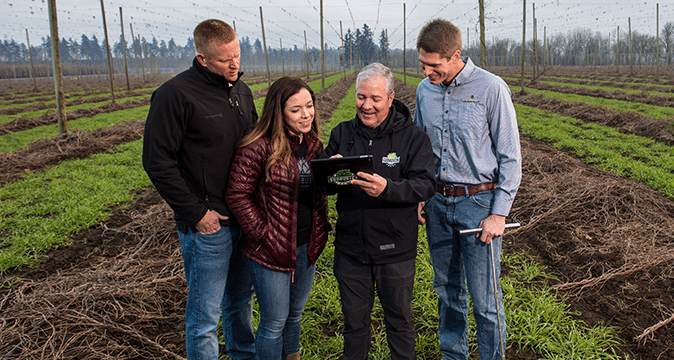Sodbuster Farms has more than 1,000 acres that includes 900 acres of hops, 100 acres of perennial rye for seed, 45 acres of hazelnuts, and 60 acres of clover and other cover crops. Recent acreage expansion and technology investment has prioritized the need for good management practices and has inspired long-term planning, with the goal of growing the farm into the fifth generation of family leadership. A strong grower-retailer relationship and the integration of 4R practices are two strategies that are paying off in improved yields, higher crop quality, and improved nutrient management.
An example of 4R principles at work is the farm’s increased application precision. Previously, soil sampling was done annually, and nutrient recommendations were blanketed farm wide. When John Peters of Wilbur-Ellis began working with the team in 2012, direct sampling was implemented each spring, followed by two-week intervals of tissue and soil sampling. Each hops field is equipped with water tanks and fertigation systems. After harvest, cones and hop plant biomass is weighed to determine nutrient removal, then placed back into the yards and recorded as nutrient credits. Soil maps, satellite imagery, chlorophyll maps, and software combine to develop precise nutrient prescriptions for VRT application.
Sodbuster has benefited greatly from this commitment to management and stewardship practices. Riparian buffers along the Willamette River system and the incorporation of cover crops has resulted in certification by Oregon’s Salmon Safe program, and quality harvesting practices have been recognized by the YCH Hops (Yakima Chief – Hopunion) Green Chief® Program. Yields continue to improve and nutrient application rates get more precise every year, ensuring success for generations to come.
Best Practice Management
- Use nitrogen stabilizer
- Use urease inhibitor to reduce nitrogen loss
- Grid soil sampling
- Variable-rate nutrient application
- Account for nutrient credits from previous year to determine rate
- Account for nutrient credits from cover crops to determine nutrient application rate
- Implement fertigation on irrigated acres to apply nutrients to the most productive areas
- Use split application for nutrients
- Approximately 70 percent to 80 percent of potassium is applied in the fall
- In-season plant tissue testing
- Foliar application of nutrients
- GPS-precision planting gets the right seed where it needs to go
- GPS-precision nutrient application avoids skips and saves on input costs
- Use satellite imaging to help identify yield potential and nutrient management plans
